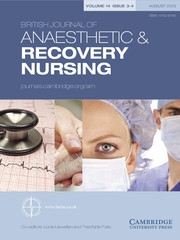Crossref Citations
This article has been cited by the following publications. This list is generated based on data provided by Crossref.
Friedel, June M.
and
Treagust, David F.
2005.
Learning bioscience in nursing education: perceptions of the intended and the prescribed curriculum.
Learning in Health and Social Care,
Vol. 4,
Issue. 4,
p.
203.
Paul, Thomas
2007.
Pulse oximetry knowledge and its effects on clinical practice.
British Journal of Nursing,
Vol. 16,
Issue. 21,
p.
1332.


